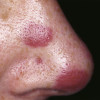Potential use of mass media to reach urban intravenous drug users with AIDS prevention messages
Abstract
To access the potential of using the mass media to reach urban intravenous drug users (IVDUs) with AIDS prevention messages,
we: 1) questioned 353 participants in a Baltimore IVDU cohort study on their media use and sources of AIDS information, 2) analyzed data on Baltimore AIDS public service announcement (PSA) airings during a 3-month period, and 3) discussed with media executives their willingness to air a variety of potential AIDS messages.… Read more

